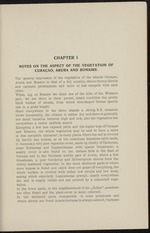| 1 |
 |
“...winds is noticed in the outward appearance
of the landscape; the tops of the trees are always stretched in
a N. E. — S. W. direction, unless they stand in protected places.
This causes these often very poorly looking trees to have a pecu-
lair appearance; the wind seems to be so strong that at the
exposed side they have hardly any leaves.
The temperature of the islands varies from 24 to 29° C.
The annual amount of the rainfall remains far behind that of the
three Dutch Windward Islands and very dry years have been
observed. The following table gives the rainfall for Curasao, Aruba
and Bonaire....”
|
|
| 2 |
 |
“...CHAPTER I
NOTES ON THE ASPECT OF THE VEGETATION OF
CURACAO, ARUBA AND BONAIRE.
The general impression of the vegetation of the islands Curagao,
Aruba and Bonaire is that of a dry country, where thorny shrubs
and cactuses predominate and more or less compete with each
other.
When, e.g. on Bonaire we climb one of the hills of the Western
part, wè see there in their purest, intact condition the pretty
thick bushes of shrubs, from which tree-shaped Cereus species
rise to a great height.
Since everywhere in the three islands a strong N.E. monsoon
blows incessantly, the climate is rather dry and there is generally
not much variation between high and low, also the vegetation has
everywhere a rather uniform aspect.
Excepting a few less exposed parts and the higher tops of Curagao
and Bonaire, the whole vegetation may be said to have a more
or less xerophile character; in many places where the soil is covered
bij hardly any humus, as on the numerous limestone table lands,
it becomes a very poor...”
|
|
